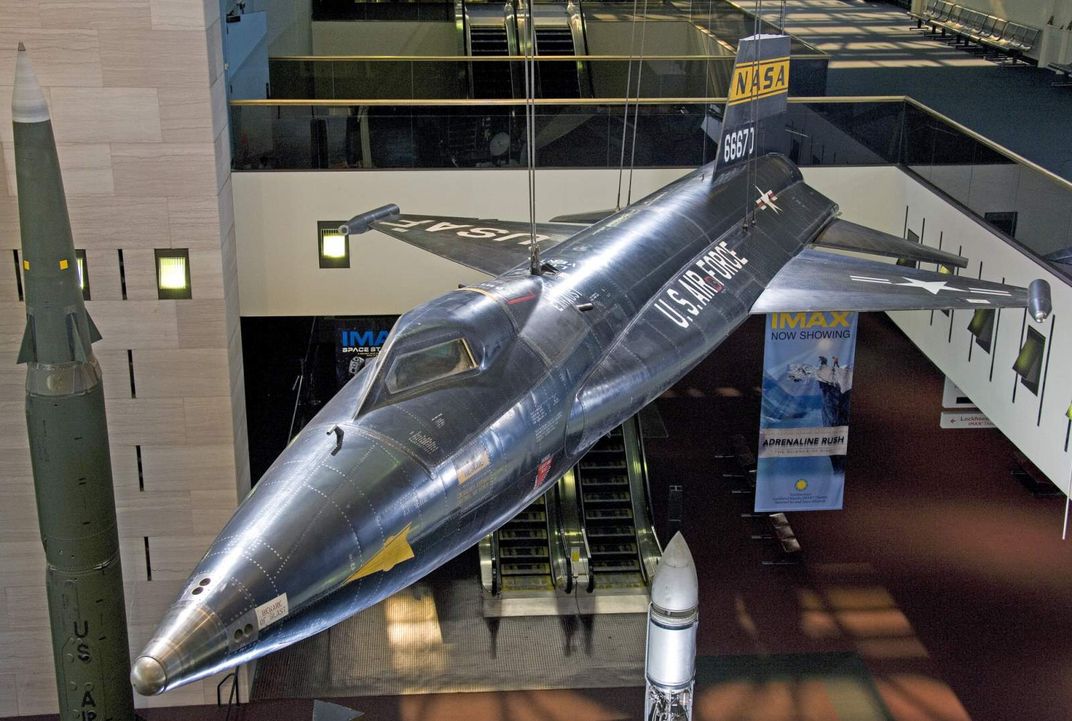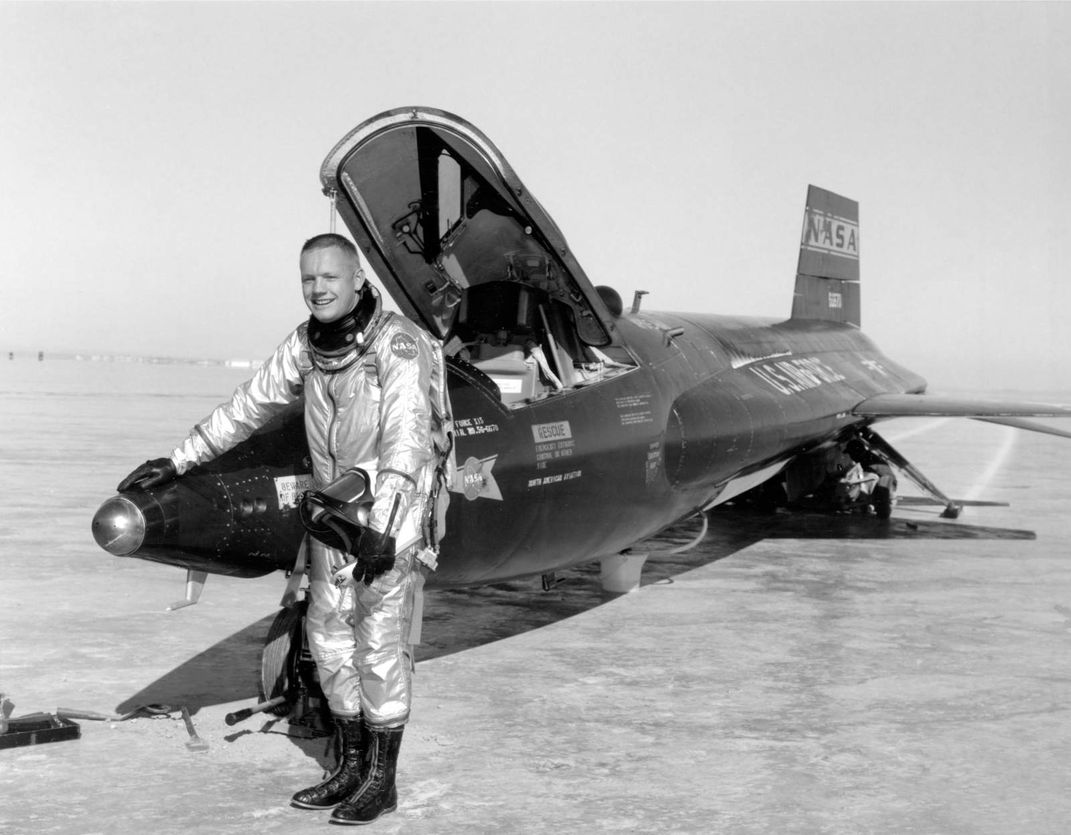Smithsonian Curator Reflects on What ‘First Man’ Gets Right About Neil Armstrong’s Journey to the Moon
The new film lays bare the personal sacrifice and peril that accompanied NASA’s historic mission
:focal(373x73:374x74)/https://tf-cmsv2-smithsonianmag-media.s3.amazonaws.com/filer/0f/e4/0fe4fde6-4af4-4162-915a-7ae6ff6c3e86/firstman3-0-1538680009.jpg)
The new film First Man, Damien Chazelle’s portrayal of the first flight to the surface of the moon, strips the Apollo program down to its most basic and fundamental component: a single human being.
More than an epic telling of Project Apollo, the film is a study of Neil Armstrong, played by Ryan Gosling, who was in life a reserved and somber engineer who endured mishap after tragedy on his way to completing one of the nation’s most historical and tactical feats of engineering and spaceflight.
We meet Armstrong strapped into the X-15 rocket plane, dropped from a large B-52 mother ship before he ignites his own craft’s engine and hurtles up to the edge of space.
“I thought starting the film with the X-15 flight was both a very powerful way to begin the movie and a great touchstone for the pilot and engineer that Mr. Armstrong was,” says Margaret Weitekamp, a curator at the Smithsonian’s National Air and Space Museum, now home to Armstrong’s X-15, which is displayed in the museum’s storied Boeing Milestones of Flight Hall.

Weitekamp studies the social and cultural dimensions of spaceflight and had the chance to meet the famous astronaut before he died in 2012. “It was something he was most proud of,” she says of the X-15 flights.
The opening flight scene sets the stage for a recurring theme: Neil Armstrong had some close calls. At more than 200,000 feet, well above the atmosphere, Armstrong’s space plane “balloons,” nearly failing to reenter and return to Earth. Later, his Gemini 8 spacecraft goes into an uncontrolled spin, and then he has to punch out of the Lunar Landing Research Vehicle while practicing on the ground. Armstrong heroically walks away from these flights and the difficult training practices thanks to his piloting expertise and deep understanding of the machinery. But each time, he walks away with a keen perspective on the severity of his task.
Between missions, the rattle and din of high-speed flight fades away, and the story follows the man and his family—a study of the profound burden of responsibility they share.
“[Armstrong] was a very careful steward of the responsibility that he carried,” says Weitekamp, “He tended to answer things in a considered and thoughtful way.”
Weitekamp describes the film’s personal moments as “almost claustrophobically intimate and close,” as the familiar cast of spaceflight's historic characters—Buzz Aldrin, Gus Grissom, Frank Borman, John Glenn, Wally Schirra, Jim Lovell and Michael Collins (who later became the third director of the National Air and Space Museum)—fade in and out of the background. Chazelle and screenwriter Josh Singer are less interested in the epic retelling of the Apollo Program as they are in exploring how the acute awareness of such a moment influenced an individual and his family.
“What I was struck with in the film is how much artistic interpretation has gone into it,” Weitekamp says. “I thought the overall impression of the film is not documentary. It’s very much setting a mood, a character exploration, and then following the arc of this life and the lives entwined with his.”
For Weitekamp, the portrayal of the astronauts’ families was one of the most successful parts of First Man. The burden of Apollo did not just fall on NASA and the astronauts, but also on the wives and children, the neighbors and entire spaceflight community.
“When the astronauts moved to Clear Lake [near Houston], they did end up moving into subdivisions together,” Weitekamp says. “They picked houses that backed up to each other, and there were astronauts who put a gate through the back fence so that they could visit each other without having to be subject to public scrutiny.”
But despite the community in First Man, Armstrong himself is depicted as a loner, as though he always knew his unique role required him to remain something of an outsider. His encounters with setback after setback, including the tragic loss of his young daughter to cancer, and the launchpad fire that kills his fellow astronauts on Apollo 1, are as dramatic in the film as they must have been in real life.
“The reality is that when there were losses, those were deeply personal losses for the people who were working in that program,” Weitekamp says. “They knew the people, they knew their families, so that was not inconsequential for how they would get up the next morning and go back to work.”

While Armstrong has the fortitude to endure the program’s consumption of his life, he is also forced to accept the fact that he has sacrificed his role as father and husband to lead humanity to the moon. The film delves equally well into the character of Janet Shearon Armstrong, portrayed by Claire Foy. As the wife of an astronaut, her own sacrifices to Apollo are a reconciling factor that drives the film’s focus on the costs and rigor of what it took to put a human being on the moon.
But despite the change in focus for a spaceflight movie, First Man still contains powerful reminders of the monumental achievement of Apollo. “The first views of the lunar surface are incredibly striking," Weitekamp says. “The first view of the Saturn V gives it a beat.”
Weitekamp says that while First Man is a departure from classic spaceflight movies, such as Apollo 13 and The Right Stuff, it is still very much “in conversation with the earlier films.” First Man’s creators are “able to do something, I think, very different with the story.”
The history of the moon landing almost serves as a backdrop to the personal story—until Armstrong steps onto the lunar dust for the first time, staring down at his own boot print, and the character arc collides with the significance of that step. The film provides another path to the surface of the moon, one that most people haven’t taken before.
“I will be interested to see, beyond the awards I think [First Man] will garner in the cinematic world, where there might be broader impact,” Weitekamp says.
Smithsonian Theaters is currently screening First Man in the Lockheed Martin IMAX Theater in the National Air and Space Museum on the National Mall in Washington, D.C. and also in the Airbus IMAX Theater at the Udvar-Hazy Center in Chantilly, Virginia.
/https://tf-cmsv2-smithsonianmag-media.s3.amazonaws.com/accounts/headshot/bennett.jpg)


/https://tf-cmsv2-smithsonianmag-media.s3.amazonaws.com/accounts/headshot/bennett.jpg)